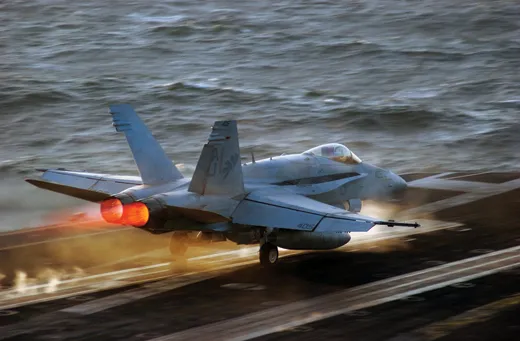How Things Work: Afterburners
Jets get no kick from champagne, but a little fuel in the tailpipe…
When a jet needs an extra kick to launch from an aircraft carrier, punch past Mach 1, or evade enemy weapons, it uses its afterburner.
Producing a big jolt of thrust—and dramatic flame—the afterburner is a simple design dating to World War II, when engineers in Germany, the United States, and elsewhere tinkered with ways to boost the thrust of underpowered jet engines without adding much weight.
Americans tested their first afterburning engine in 1943, and six decades later afterburners remain in use among the latest generation of U.S. warplanes, which can achieve supersonic cruise speeds without them but continue to rely on them for critical maneuvers.
A typical jet engine uses only about half the oxygen it ingests, leaving a large amount of potential energy. The afterburner, which is a long extension at the back of the engine, combines much of the remaining oxygen with jet fuel, squirted into the high-speed exhaust stream from the engine’s turbine, and ignites the mixture. The resulting blowtorch shoots through a nozzle at the back of the engine, providing a hard kick of extra thrust.
The size of the boost varies. The afterburners on the Olympus engines that powered the Concorde supersonic jet added only about 17 percent to that engine’s thrust.
For the engines that power modern fighters, the increase ranges from about 40 to 70 percent. One hallmark of an afterburning engine is inefficiency: Using it guzzles up to three times as much fuel, so pilots typically limit its use to a few minutes per mission.
Although the design of an afterburner is simple, it operates with extremely sensitive tolerances. Maintaining a stable flame is the first challenge, since ignition needs to occur within air racing from the engine’s turbine into the afterburner at several hundred feet per second.
“It’s like lighting a butane lighter when you’re sticking it out the window of your car and holding it behind the side mirror,” says Derk Philippona, an engineer with a fellowship at Pratt & Whitney, which produces several afterburner-equipped engines, including those for the U.S. Air Force’s F-22A Raptor.
Fuel enters through a series of small tubes—typically 10 or so—that form a ring around the engine. The fuel sprays from hundreds of tiny holes in the tubes into the air stream, where it’s ignited, usually by an electric sparking device.
“You need to insure that when you spray fuel into the high-velocity air stream, it doesn’t just blow out the tailpipe,” says Louis Povinelli, chief scientist for turbomachinery and propulsion systems at NASA’s Glenn Research Center in Cleveland, Ohio. The ignition process is “still somewhat of a black art,” he says.
The afterburner is designed so that the flame flows along its axis, away from its walls. Careful placement of the fuel tubes and the ignition source at the front end of the jetpipe (the four- to seven-foot-long tube at the back of the engine), where hot but not burning exhaust gas is flowing out of the engine, creates a stable zone in the airflow where air and fuel can mix.
The stable flow ensures that the flame ignites quickly and burns at a consistent location. If the flame moves around, it could set up oscillations that eventually could burn through the jetpipe or damage the end of the exhaust nozzle.
Designers often also add pilot lights downstream from the ignition spot to make sure that the flame burns evenly and consumes all of the fuel that flows into the afterburner.
Another challenge is keeping the metal jetpipe cool in the afterburner’s high temperatures, which can reach 3,000 degrees Fahrenheit.
“People keep pushing the limit between the gas temperature and the melting point” of the engine components, says Povinelli. “The materials aren’t any different than other parts of the engine, and the walls aren’t especially thick.”
Cold fuel flowing through tubes at the top of the afterburner absorbs some of the heat, Povinelli explains.
More recent turbofan engines add a flow of cold air through a ring around the barrel-shaped engine, bypassing its combustion chamber. At high altitudes the temperature is well below zero, and the influx of cold air into the afterburner pipe helps protect it against the flaming
exhaust.
As the exhaust races out the back, the engine’s nozzle is designed to open wider to accommodate the extra volume of hot gas, preventing any increase in pressure inside the engine.
One problem with this arrangement, engineers note, is that things that tend to be good for combustion are bad for stealth, and vice versa.
With afterburners, the open tailpipe welcomes enemy radar waves, which enter the hole and bounce back a strong signal even when the afterburner is not lit.
It is also nearly impossible to hide the infrared emissions from a lit afterburner and its nozzle—structures that stealth airplanes like the B-2 and F-117 don’t have.
Using a turbofan, which mixes cool air with the turbine exhaust gases, helps decrease the signature a little.
Future designs, featuring afterburner nozzles built into the fuselage and cooled with bypass air, may mask the jetpipe’s infrared emissions. Engineers also are evaluating construction materials that absorb heat, similar to space shuttle thermal tiles, and other engine designs that would create stealthier afterburners.
But there is no way to fully hide a plume of hot air roaring from the back of a warplane. The only way to preserve stealth is to reduce the reliance on afterburners. The F-22A, for example, can cruise at about 1.5 times the speed of sound without lighting the afterburner.
Still, aviation engineers say afterburners will remain in use well into the 21st century. Although carrier takeoffs are the most common of current uses of the afterburner, extra speed is always useful in combat. As long as military pilots might need extra bursts of power, afterburners are likely to remain the solution.
